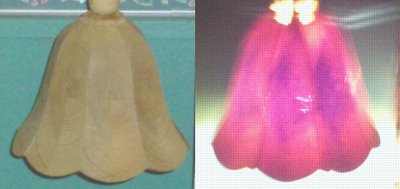Annikki finds all sorts of things in the local flea markets.
I thought I would feature some of her best finds, usually bought at an Euro or two. (Wish I had a better camera to get the real beauty of many of her finds.)
Here is one that she found a long time ago.
It is a wooden lamp shade.
When you switch on the light, the colour is a beautiful glow of red showing the intricate design work that has been carved into it.
It is supposedly made from Red Ceddar wood, but the plain wood, in this instance, does not show the characteristic red colouration associated with this type of wood.
The beautiful colour glow, which can be seen in the photo on the right, is supposedly characteristic of light shining through this wood.
This is a write up about Eastern Red Cedar.
Eastern Red Cedar - Juniperus virginiana
General Information: Red cedar is an evergreen growing 40 to 50 feet tall in an oval, columnar, or pyramidal form (very diverse) and spreading 8 to 15 feet when given a sunny location. It develops a brownish tint in winter in the north and is sometimes used in windbreaks or screens. The fruit is a blue berry on female trees and is ornamental when produced in quantity. Birds devour the fruit and 'plant' it along farm fences and in old abandoned fields. Some botanists do not separate J. virginiana from silicicola.
The eastern red cedar is not a true cedar (genus Cedrus), it is actually a variety of juniper. It occurs naturally as an upright tree with many small branches, curving sharply upward. Old trees often have many natural jin on the lower part of the trunk, and that branches are more nearly horizontal. The wood of the red cedar is fragrant and is used extensively for furniture. The foliage is bright green to dark green.
With sufficient early training, the red cedar can be used for most styles, though multiple-trunk styles probably require planting multiple trees close together. Cascade and semi-cascade styles could be a challenge, given the strong apex dominance of this tree.
Here is a write up about Western Red Cedar.
WESTERN RED CEDAR
thuja plicata
* other common names: Giant Arbor-Vitae, Canoe-cedar, Pacific Red-cedar, Shinglewood
* the western red cedar is British Columbia's official tree
* can be referred to as 'arbor-vitae' or "tree of life"
UNIQUE FEATURES:
* drooping branches that turn up at tip
* trunk spreading out at the base
* has large number of cones bent backward along the branches
Surprisingly, there is no mention as to why Red Cedar, Eastern or Western, has been called by that name. The wood does have a red colouration, and wood panelling made of Red Cedar certainly is attractive. But there is no mention of the light transmission properties which yields this beautiful colouration.
My valuation of this lamp is that it must be worth several tens of euros, if not more.
Great find.
No comments:
Post a Comment